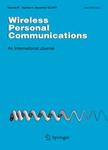版权所有:内蒙古大学图书馆 技术提供:维普资讯• 智图
内蒙古自治区呼和浩特市赛罕区大学西街235号 邮编: 010021

作者机构:Nanyang Technol Univ Sch Elect & Elect Engn Singapore 639798 Singapore Southeast Univ Natl Mobile Communicat Res Lab Nanjing 210096 Peoples R China Nanyang Technol Univ Sch Elect & Elect Engn Singapore 639798 Singapore Beijing Jiaotong Univ State Key Lab Rail Traff Control & Safety Beijing 100044 Peoples R China Southeast Univ Natl Mobile Commun Res Lab Nanjing 210096 Peoples R China
出 版 物:《WIRELESS PERSONAL COMMUNICATIONS》 (无线个人通信)
年 卷 期:2009年第49卷第2期
页 面:263-274页
核心收录:
学科分类:0810[工学-信息与通信工程] 0809[工学-电子科学与技术(可授工学、理学学位)] 08[工学]
基 金:Natural Science Foundation of China [60572036, 50534060] National High Technology Project of China [(2007AA10Z259] National Mobile Communications Research Laboratory, Southeast University, China
主 题:Space-time block code Orthogonal design Transmit diversity Code rate
摘 要:Based on orthogonal designs, space-time (ST) block codes that enable full diversity as well as a simple maximum likelihood (ML) decoding algorithm at the decoder can be constructed for more than two transmit antennas. For real constellations (such as PAM), ST block codes with transmission rate 1 can be designed from the real Hurwitz-Radon families for any number of transmit antennas. However, for complex constellations (such as M-PSK or M-QAM), ST block codes for more than two transmit antennas can only be constructed with rates less than 1. Previous attempts have been concentrated on complex orthogonal designs that provide ST block codes with full diversity and high transmission rates. In this paper, we present two rate 2/3 complex ST block codes from orthogonal designs for five and six transmit antennas, respectively. Simulation results are provided to demonstrate the significant performance gains made by the proposed ST block codes.